MENU
The Electronic Scholarly Publishing Project: Providing access to classic scientific papers and other scholarly materials, since 1993. More About: ESP | OUR CONTENT | THIS WEBSITE | WHAT'S NEW | WHAT'S HOT
Comparative Timelines
The ESP Timeline (one of the site's most popular features) has been completely updated to allow the user to select (using the timeline controls above each column) different topics for the left and right sides of the display.
Select:
New Left Column
New Left Column
Dates
Decade
New Right Column
New Right Column
(no entry for this year)
1940
Frank Morton Carpenter collects a 2.5-foot wing from a dragonfly-like giant insect that lived in Oklahoma during the Permian Period.
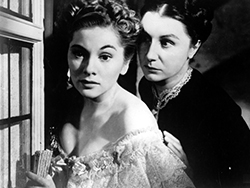 Rebecca wins Academy Award for best picture. The darkest aspects of the Daphne du Maurier novel were cleaned up a little, but the film was popular then and still remains a fan favorite. It's the only Alfred Hitchcock film to take the top Academy Award.
Rebecca wins Academy Award for best picture. The darkest aspects of the Daphne du Maurier novel were cleaned up a little, but the film was popular then and still remains a fan favorite. It's the only Alfred Hitchcock film to take the top Academy Award.
(no entry for this year)
1941
Between 1941 and 1945, the desperate need for labor in US defense plants and shipyards leads to the migration of 1.2 million African-Americans from the South to the North and West. This migration transforms American politics as blacks increasingly vote in their new homes and put pressure on Congress to protect civil rights throughout the nation. Their activism lays much of the foundation for the national civil rights movement a decade later.
On June 25, Pres. Franklin Roosevelt issues Executive Order 8802, which desegregates US defense plants and shipyards and creates the Fair Employment Practices Committee.
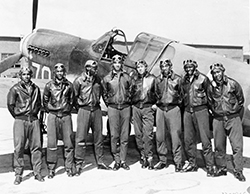 The US Army creates the Tuskegee Air Squadron (the 99th Pursuit Squadron) — an all African-American flying unit.
The US Army creates the Tuskegee Air Squadron (the 99th Pursuit Squadron) — an all African-American flying unit.
Zuse Z3 machine completed
G. W. Beadle and E. L. Tatum publish their classic study on the biochemical genetics of Neurospora and promulgate the ONE-GENE, ONE-ENZYME theory.
K. Mather coins the term polygenes and describes polygenic traits in various organisms.
Anthropologist E. T. Hall excavates the ruins of a dwelling in New Mexico occupied between 700 and 900 AD. He finds two fossil jawbones of Eocene mammals that were deliberately carried to the dwelling by Paleo- Indians.
German paleontologist H. Kirchner suggests that dinosaur tracks in the Rhine Valley might have inspired the legend of Siegfried slaying the dragon Fafnir.
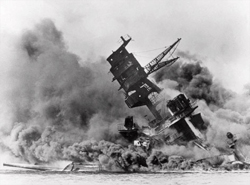 07 DEC 1941: Pearl Harbor bombed by Japanese The US immediately declares war on Japan. Germany quickly declares war on the United States. The US is now a full participant in World War II.
07 DEC 1941: Pearl Harbor bombed by Japanese The US immediately declares war on Japan. Germany quickly declares war on the United States. The US is now a full participant in World War II.
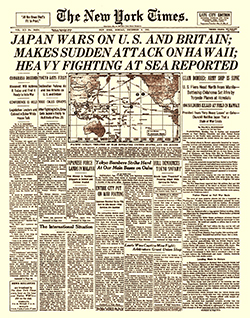 08 DEC 1941: The US responds to Pearl Harbor. President to address joint session of Congress. Declaration of War expected.
08 DEC 1941: The US responds to Pearl Harbor. President to address joint session of Congress. Declaration of War expected.
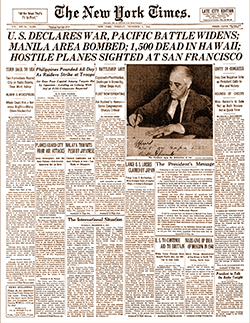 09 DEC 1941: The United States formally declares War on Japan.
09 DEC 1941: The United States formally declares War on Japan.
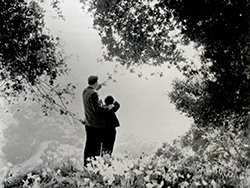 How Green Was My Valley wins Academy Award for best picture. The drama was set in a Welsh mining village, with director John Ford winning one of the film's five Oscars. Even then, many were surprised that the movie beat Orson Welles Citizen Kane, but a Variety reporter at the time attributed that to the 6,000 movie extras who voted on Oscar's top prize: The mob prefers a regular guy to a genius.
How Green Was My Valley wins Academy Award for best picture. The drama was set in a Welsh mining village, with director John Ford winning one of the film's five Oscars. Even then, many were surprised that the movie beat Orson Welles Citizen Kane, but a Variety reporter at the time attributed that to the 6,000 movie extras who voted on Oscar's top prize: The mob prefers a regular guy to a genius.
Kodacolor, the first color film that yields negatives for making chromogenic color prints on paper. Roll films for snapshot cameras only, 35 mm not available until 1958.
1942
The Atanasoff-Berry Computer is completed
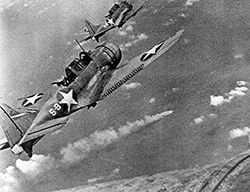 4-7 JUN 1942: The Battle of Midway occurs. Less than six months after Pearl Harbor the Japanese navy attempts to lure the remnants of the US Navy into a decisive battle at Midway Island. The Japanese plan backfires, as the battle proves to be a huge victory for US forces and the turning point in the war in the Pacific.
4-7 JUN 1942: The Battle of Midway occurs. Less than six months after Pearl Harbor the Japanese navy attempts to lure the remnants of the US Navy into a decisive battle at Midway Island. The Japanese plan backfires, as the battle proves to be a huge victory for US forces and the turning point in the war in the Pacific.
Ernst Mayr publishes Systematics and the Origin of Species, and Julian Huxley publishes Evolution: The Modern Synthesis. Both books are significant contributions to the neo darwinian synthesis combining elements of natural selection, genetics, mutation, population biology and paleontology.
S. E. Luria and T. F. Anderson publish the first electron micrographs of bacterial viruses. T2 has a polyhedral body and a tail.
 Mrs. Miniver wins Academy Award for best picture. The film, about a British family during the early days of World War II, came at just the right time, reassuring Americans that their newish war effort was the right decision.
Mrs. Miniver wins Academy Award for best picture. The film, about a British family during the early days of World War II, came at just the right time, reassuring Americans that their newish war effort was the right decision.
(no entry for this year)
1943
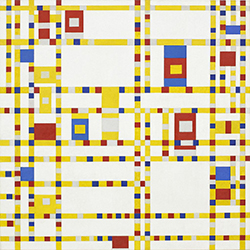 Painting by Piet Mondrian: Broadway Boogie Woogie was completed in 1943, shortly after Mondrian moved to New York in 1940. Compared to his earlier work, the canvas is divided into a much larger number of squares. Although he spent most of his career creating abstract work, this painting is inspired by clear real-world examples: the city grid of Manhattan, and the Broadway boogie woogie, a type of music Mondrian loved. The painting was bought by the Brazilian sculptor Maria Martins for the price of $800 at the Valentine Gallery in New York City, after Martins and Mondrian both exhibited there in 1943. Martins later donated the painting to the Museum of Modern Art in New York City.
Painting by Piet Mondrian: Broadway Boogie Woogie was completed in 1943, shortly after Mondrian moved to New York in 1940. Compared to his earlier work, the canvas is divided into a much larger number of squares. Although he spent most of his career creating abstract work, this painting is inspired by clear real-world examples: the city grid of Manhattan, and the Broadway boogie woogie, a type of music Mondrian loved. The painting was bought by the Brazilian sculptor Maria Martins for the price of $800 at the Valentine Gallery in New York City, after Martins and Mondrian both exhibited there in 1943. Martins later donated the painting to the Museum of Modern Art in New York City.
The Colossus Mark 1 computer is delivered to Bletchley Park
The First Computing Journal
Work begins on ENIAC
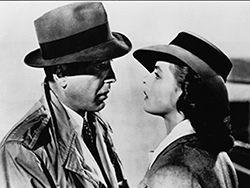 Casablanca wins Academy Award for best picture. The WWII drama represents the studio system at its best, where all the talent (behind and in front of the camera) worked at their peak. Humphrey Bogart and Ingrid Bergman were not the studio's first choices for their roles, but they remain one of the screen's all-time great romantic pairings.
Casablanca wins Academy Award for best picture. The WWII drama represents the studio system at its best, where all the talent (behind and in front of the camera) worked at their peak. Humphrey Bogart and Ingrid Bergman were not the studio's first choices for their roles, but they remain one of the screen's all-time great romantic pairings.
(no entry for this year)
1944
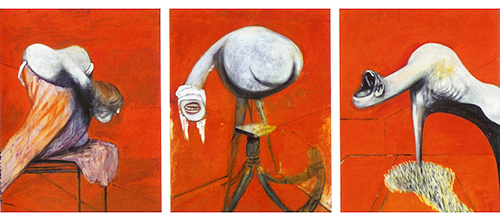 Triptych by Francis Bacon: Three Studies for Figures at the Base of a Crucifixion comprises three canvasses that are based on the Eumenides — or Furies — of Aeschylus's Oresteia, and that depict three writhing anthropomorphic creatures set against a flat burnt orange background. It was executed in oil paint and pastel on Sundeala fibre board and completed within two weeks. The triptych summarises themes explored in Bacon's previous work, including his examination of Picasso's biomorphs and his interpretations of the Crucifixion and the Greek Furies. The Three Studies are generally considered Bacon's first mature piece. When the painting was first exhibited in 1945 it caused a sensation and established him as one of the foremost post-war painters. Remarking on the cultural significance of Three Studies, the critic John Russell observed in 1971 that "there was painting in England before the Three Studies, and painting after them, and no one ... can confuse the two".
Triptych by Francis Bacon: Three Studies for Figures at the Base of a Crucifixion comprises three canvasses that are based on the Eumenides — or Furies — of Aeschylus's Oresteia, and that depict three writhing anthropomorphic creatures set against a flat burnt orange background. It was executed in oil paint and pastel on Sundeala fibre board and completed within two weeks. The triptych summarises themes explored in Bacon's previous work, including his examination of Picasso's biomorphs and his interpretations of the Crucifixion and the Greek Furies. The Three Studies are generally considered Bacon's first mature piece. When the painting was first exhibited in 1945 it caused a sensation and established him as one of the foremost post-war painters. Remarking on the cultural significance of Three Studies, the critic John Russell observed in 1971 that "there was painting in England before the Three Studies, and painting after them, and no one ... can confuse the two".
On April 3, the United States Supreme Court in Smith vs. Allright declares white-only political primaries unconstitutional.
First Harvard Mark 1 shipped
 D-Day landing On June 6th, the largest amphibious force ever assembled, led by General Dwight D. Eisenhower, successfully attacks and establishes a landing on the coast of France at Normandy.
D-Day landing On June 6th, the largest amphibious force ever assembled, led by General Dwight D. Eisenhower, successfully attacks and establishes a landing on the coast of France at Normandy.
Theoretical physicist Erwin Schrödinger publishes What is Life? arguing that living organisms store and pass along information, perhaps using something like Morse code. This book will inspire James Watson, Francis Crick and Maurice Wilkins, who will share the Nobel prize for discovering the structure of DNA.
O. T. Avery, C. M. MacLeod, and M. McCarty describe the pneumococcus transforming principle. The fact that it is rich in DNA suggests that DNA and not protein is the hereditary chemical.
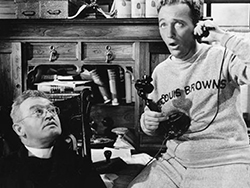 Going My Way wins Academy Award for best picture. Writer-director Leo McCarey once again proved his ability to balance tears and laughs, in this tale of a rule-breaking priest (Oscar winner Bing Crosby) taking over a New York parish from a retiring priest. In the latter role, Barry Fitzgerald was oddly nominated as both lead and supporting actor, winning in the latter category.
Going My Way wins Academy Award for best picture. Writer-director Leo McCarey once again proved his ability to balance tears and laughs, in this tale of a rule-breaking priest (Oscar winner Bing Crosby) taking over a New York parish from a retiring priest. In the latter role, Barry Fitzgerald was oddly nominated as both lead and supporting actor, winning in the latter category.
(no entry for this year)
1945
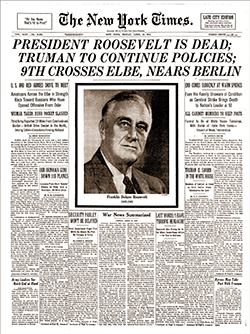 13 APR 1945: President Roosevelt dies in office.
13 APR 1945: President Roosevelt dies in office.
 Harry S. Truman becomes thirty-third president of the United States.
Harry S. Truman becomes thirty-third president of the United States.
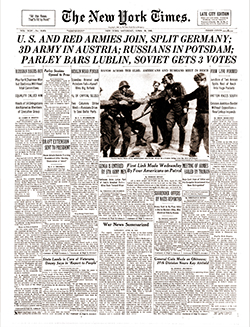 28 APR 1945: US and Russian troops meet. Germany split in two.
28 APR 1945: US and Russian troops meet. Germany split in two.
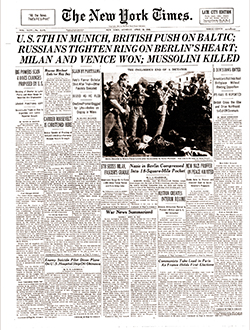 30 APR 1945: Press reports Mussolini killed by Italian partisans, his body abused. Hitler commits suicide by gunshot while hiding in his Führerbunker, but news of his death will not surface for a few days.
30 APR 1945: Press reports Mussolini killed by Italian partisans, his body abused. Hitler commits suicide by gunshot while hiding in his Führerbunker, but news of his death will not surface for a few days.
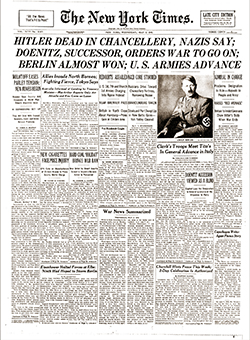 02 MAY 1945: Hitler reported dead..
02 MAY 1945: Hitler reported dead..
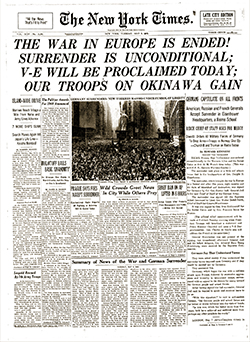 08 MAY 1945: Germany surrenders unconditionally. The war in Europe is over.
08 MAY 1945: Germany surrenders unconditionally. The war in Europe is over.
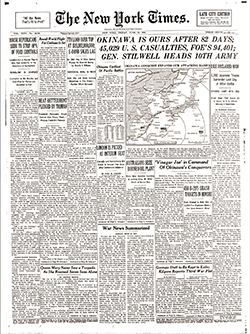 22 JUN 1945: Okinawa falls after 82 days of fierce fighting.
22 JUN 1945: Okinawa falls after 82 days of fierce fighting.
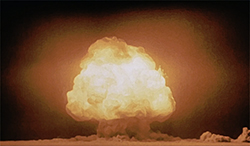 16 JUL 1945: The Manhattan Project yields results — the world's first atomic bomb is secretly tested in New Mexico.
16 JUL 1945: The Manhattan Project yields results — the world's first atomic bomb is secretly tested in New Mexico.
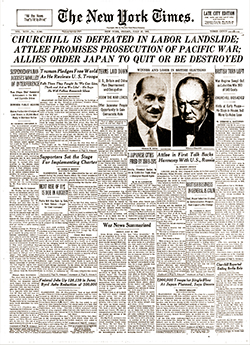 27 JUL 1945: Churchill is defeated in British elections. Potsdam Declaration is reported, calling for Japan to surrender unconditionally or face "prompt and utter destruction."
27 JUL 1945: Churchill is defeated in British elections. Potsdam Declaration is reported, calling for Japan to surrender unconditionally or face "prompt and utter destruction."
 06 AUG 1945: the first atomic bomb used in combat is dropped on Hiroshima, Japan.
06 AUG 1945: the first atomic bomb used in combat is dropped on Hiroshima, Japan.
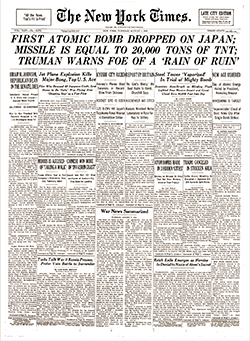 07 AUG 1945: The world learns about the atomic bomb. President Truman announces "The force from which the sun draws its power has been loosed against those who brought war to the Far East" and he calls upon Japan to immediately accept the terms of the Potsdam Declaration or expect a rain of ruin from the air, the like of which has never been seen on this earth."
07 AUG 1945: The world learns about the atomic bomb. President Truman announces "The force from which the sun draws its power has been loosed against those who brought war to the Far East" and he calls upon Japan to immediately accept the terms of the Potsdam Declaration or expect a rain of ruin from the air, the like of which has never been seen on this earth."
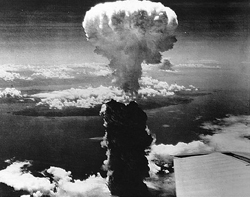 09 AUG 1945: The second atomic bomb used in combat is dropped on Nagasaki, Japan. The primary target for this mission was actually the city of Kokura, but the bomber crew moved on to the secondary target of Nagasaki when Kokura proved to be too obscured by smoke to get a clear view for the bombsight. Russia declares war on japan.
09 AUG 1945: The second atomic bomb used in combat is dropped on Nagasaki, Japan. The primary target for this mission was actually the city of Kokura, but the bomber crew moved on to the secondary target of Nagasaki when Kokura proved to be too obscured by smoke to get a clear view for the bombsight. Russia declares war on japan.
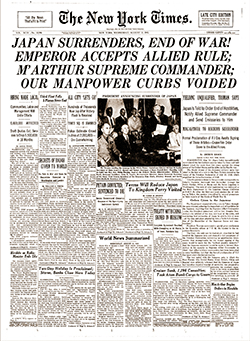 15 AUG 1945: In the afternoon of August 15th (Japanese time), Japan announces its unconditional surrender. World War II is finally over. More than 60 million people have died as a result of the conflict.
15 AUG 1945: In the afternoon of August 15th (Japanese time), Japan announces its unconditional surrender. World War II is finally over. More than 60 million people have died as a result of the conflict.
 Col. Benjamin O. Davis, Jr, is named commander of Godman Field, Kentucky. He is the first African-American to command a United States military base.
Col. Benjamin O. Davis, Jr, is named commander of Godman Field, Kentucky. He is the first African-American to command a United States military base.
Grace Hopper recorded the first actual computer "bug"
Patent is Filed for the Harvard Mark I
Vannevar Bush publishes his ideas for MEMEX, a proto-hypertext system and forerunner to the World Wide Web
 S. E. Luria demonstrates that mutations occur in bacterial viruses.
S. E. Luria demonstrates that mutations occur in bacterial viruses.
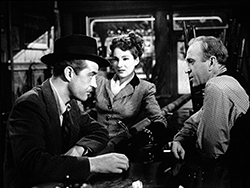 The Lost Weekend wins Academy Award for best picture. The film, directed by Billy Wilder, was widely admired even though it was controversial: Though movies had featured drunks since the silent days, it was considered daring to address the subject head-on.
The Lost Weekend wins Academy Award for best picture. The film, directed by Billy Wilder, was widely admired even though it was controversial: Though movies had featured drunks since the silent days, it was considered daring to address the subject head-on.
(no entry for this year)
1946
The United States Supreme Court, in Morgan vs Virginia, rules that segregation in interstate bus travel is unconstitutional.
Alan Turing Proposal For 'ACE' Automatic Computing Engine
ENIAC Unveiled
ENIAC, short for Electronic Numerical Integrator And Computer was announced
Frederick Williams Receives Patent for RAM device
 Nobel Prize in Medicine awarded to H. J. Muller for his contributions to radiation genetics
Nobel Prize in Medicine awarded to H. J. Muller for his contributions to radiation genetics
Genetic recombination in bacteriophage is demonstrated by M. Delbrück and W. T. Bailey and by A. D. Hershey.
J. Lederberg and E. L. Tatum demonstrate genetic recombination in bacteria.
Along the Kolyma River in northeastern Siberia, Gulag prisoners discover a nest with three frozen, mummified ground squirrel carcasses. They turn the carcasses over to the Gulag camp geologist, Yuriy Popov, who relays them to other Soviet scientists. Seventy years later, radiocarbon dating and DNA analysis of the ground squirrel mummies will identify their age at over 30,000 years old, and indicate that they are not direct ancestors of modern ground squirrels in the region.
Geologist Reg Sprigg discovers fossils near the Ediacara Hills in Australia. The fossils are of multicellular organisms that predated the Cambrian Period, making them the oldest complex fossils yet discovered. At least some of the fossils are generally assumed to be related to modern cnidarians like jellyfish and corals.
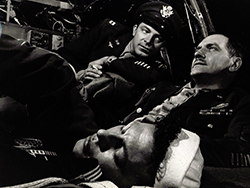 The Best Years of Our Lives wins Academy Award for best picture. The world population was just adjusting to life after World War II and some film executives feared that audiences wanted escapism, not a movie reflecting their lives. But it was a huge hit, and its honesty in dealing with civilian changes and vulnerabilities are still powerful. It was produced by Samuel Goldwyn, directed by William Wyler.
The Best Years of Our Lives wins Academy Award for best picture. The world population was just adjusting to life after World War II and some film executives feared that audiences wanted escapism, not a movie reflecting their lives. But it was a huge hit, and its honesty in dealing with civilian changes and vulnerabilities are still powerful. It was produced by Samuel Goldwyn, directed by William Wyler.
Dennis Gabor invents holography.
Harold Edgerton develops the Rapatronic camera for the U.S. government.
1947
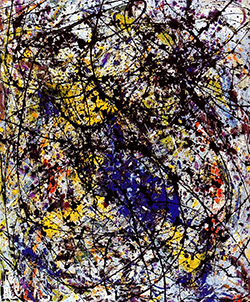 Painting by Jackson Pollock: Reflections of the Big Dipper, consisting of built up layers of paint with dripped enamel as the final touch, concluding the composition. It was around 1947 that Jackson Pollock traded in his brushes for sticks, trowels and knives and began adding foreign matter, such as sand, broken glass, nails, coins, paint-tube tops and bottle caps to his canvases. Reflection of the Big Dipper was exhibited at the Betty Parsons Gallery in 1948, along with sixteen other paintings by Jackson Pollock. The show received positive reviews. Pollock's works from this time are a transitional step between a more traditional handling of paint and his revolutionary technique of dripping paint on canvases off a large scale.
Painting by Jackson Pollock: Reflections of the Big Dipper, consisting of built up layers of paint with dripped enamel as the final touch, concluding the composition. It was around 1947 that Jackson Pollock traded in his brushes for sticks, trowels and knives and began adding foreign matter, such as sand, broken glass, nails, coins, paint-tube tops and bottle caps to his canvases. Reflection of the Big Dipper was exhibited at the Betty Parsons Gallery in 1948, along with sixteen other paintings by Jackson Pollock. The show received positive reviews. Pollock's works from this time are a transitional step between a more traditional handling of paint and his revolutionary technique of dripping paint on canvases off a large scale.
 On April 10, Jackie Robinson of the Brooklyn Dodgers becomes the first African-American to play major league baseball in the 20th century.
On April 10, Jackie Robinson of the Brooklyn Dodgers becomes the first African-American to play major league baseball in the 20th century.
J Lyons executives report on the potential of computers to automate clerical work
The Williams tube won the race for a practical random-access memory
American Museum of Natural History curator Edwin Colbert finds a massive quarry of Coelophysis dinosaurs in New Mexico and concludes from their skeletons that these Triassic dinosaurs were swift runners with a bird- like posture. Later examination of two fossils will lead Colbert to conclude they were also cannibals, but the "last meals of juvenile coelophyses" will eventually prove to be crocodilian.
Rudolph Zallinger completes The Age of Reptiles mural in the Yale Peabody Museum. His image of slow-moving dinosaurs will prevail until the 1960s.
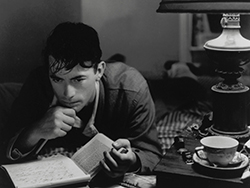 Gentleman's Agreement wins Academy Award for best picture. The Elia Kazan-directed drama, starring Gregory Peck, was another hot-button winner, as it addressed the topic of anti-Semitism.
Gentleman's Agreement wins Academy Award for best picture. The Elia Kazan-directed drama, starring Gregory Peck, was another hot-button winner, as it addressed the topic of anti-Semitism.
Edwin H. Land introduces the first Polaroid instant camera.
1948
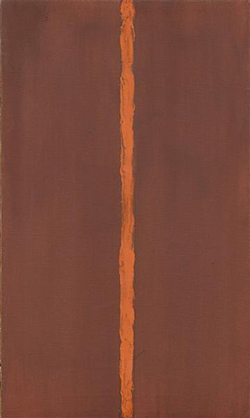 Painting by Barnett Newman: Onement I features the first full incarnation of what Newman later called a 'zip', a vertical band of color. This motif would play a central role in many of his subsequent paintings. The painting's title is an archaic derivation of the word 'atonement', meaning, "the state of being made into one."
Painting by Barnett Newman: Onement I features the first full incarnation of what Newman later called a 'zip', a vertical band of color. This motif would play a central role in many of his subsequent paintings. The painting's title is an archaic derivation of the word 'atonement', meaning, "the state of being made into one."
On July 26, Pres. Harry Truman issues Executive Order 9981, directing the desegregation of the armed forces.
The United States Supreme Court, in Shelley vs Kraemer, rules that racially restrictive covenants are legally unenforceable.
IBM´s Selective Sequence Electronic Calculator was built
The Manchester Baby, the world's first stored program computer, ran its first program
 H. J. Muller coins the term dosage compensation.
H. J. Muller coins the term dosage compensation.
J. Lederberg and N. Zinder, and, independently, B. D. Davis develop the penicillin selection technique for isolating biochemically deficient bacterial mutants.
Mary Leakey finds the skull of the ape Proconsul, about 16 million years old. Although a very significant find, it does little to bolster Louis and Mary Leakey's meager research funding.
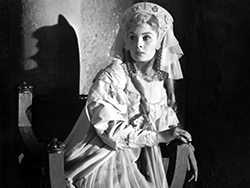 Hamlet wins Academy Award for best picture. The black and white Shakespeare adaptation, from U.K.'s J. Arthur Rank-Two Cities, was the first non-Hollywood film to take the top award. And Laurence Olivier became the first person to direct himself to a best-actor win.
Hamlet wins Academy Award for best picture. The black and white Shakespeare adaptation, from U.K.'s J. Arthur Rank-Two Cities, was the first non-Hollywood film to take the top award. And Laurence Olivier became the first person to direct himself to a best-actor win.
The Contax S camera is introduced, the first 35 mm SLR camera with a pentaprism eye-level viewfinder.
1949
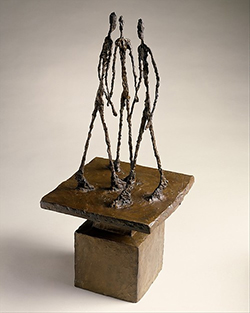 Alberto Giacometti completes Three Men Walking II
Alberto Giacometti completes Three Men Walking II
EDSAC performed its first calculations
EDSAC ran its first programs
EDVAC goes onlline
Jay Forrester Records "Core Memory" Idea
Professor Bill Phillips unveils Phillips Hydraulic Economic Modelling Computer at the LSE
A. D. Hershey and R. Rotman demonstrate that genetic recombination occurs in bacteriophage.
J. V. Neel provides genetic evidence that the sickle-cell disease is inherited as a simple Mendelian autosomal recessive.
French prehistorian André Leroi-Gourhan discovers the Cave of the Reindeer near the village of Arcy-sur-Cure where he will conduct a 15-year excavation. Discoveries at Arcy will suggest to some researchers an artistic sense among Neanderthals, including the collection of fossil mollusk shells and fossil coral. Doubts about ages of objects, however, will leave the subject open to debate.
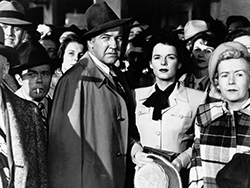 All the King's Men wins Academy Award for best picture. The movie, written and directed by Robert Rossen (nominated in both categories), was based on the novel by Robert Penn Warren. It was a thinly disguised version of Louisiana's Huey Long, and the film's observations about politics still hold up surprisingly well.
All the King's Men wins Academy Award for best picture. The movie, written and directed by Robert Rossen (nominated in both categories), was based on the novel by Robert Penn Warren. It was a thinly disguised version of Louisiana's Huey Long, and the film's observations about politics still hold up surprisingly well.
ESP Quick Facts
ESP Origins
In the early 1990's, Robert Robbins was a faculty member at Johns Hopkins, where he directed the informatics core of GDB — the human gene-mapping database of the international human genome project. To share papers with colleagues around the world, he set up a small paper-sharing section on his personal web page. This small project evolved into The Electronic Scholarly Publishing Project.
ESP Support
In 1995, Robbins became the VP/IT of the Fred Hutchinson Cancer Research Center in Seattle, WA. Soon after arriving in Seattle, Robbins secured funding, through the ELSI component of the US Human Genome Project, to create the original ESP.ORG web site, with the formal goal of providing free, world-wide access to the literature of classical genetics.
ESP Rationale
Although the methods of molecular biology can seem almost magical to the uninitiated, the original techniques of classical genetics are readily appreciated by one and all: cross individuals that differ in some inherited trait, collect all of the progeny, score their attributes, and propose mechanisms to explain the patterns of inheritance observed.
ESP Goal
In reading the early works of classical genetics, one is drawn, almost inexorably, into ever more complex models, until molecular explanations begin to seem both necessary and natural. At that point, the tools for understanding genome research are at hand. Assisting readers reach this point was the original goal of The Electronic Scholarly Publishing Project.
ESP Usage
Usage of the site grew rapidly and has remained high. Faculty began to use the site for their assigned readings. Other on-line publishers, ranging from The New York Times to Nature referenced ESP materials in their own publications. Nobel laureates (e.g., Joshua Lederberg) regularly used the site and even wrote to suggest changes and improvements.
ESP Content
When the site began, no journals were making their early content available in digital format. As a result, ESP was obliged to digitize classic literature before it could be made available. For many important papers — such as Mendel's original paper or the first genetic map — ESP had to produce entirely new typeset versions of the works, if they were to be available in a high-quality format.
ESP Help
Early support from the DOE component of the Human Genome Project was critically important for getting the ESP project on a firm foundation. Since that funding ended (nearly 20 years ago), the project has been operated as a purely volunteer effort. Anyone wishing to assist in these efforts should send an email to Robbins.
ESP Plans
With the development of methods for adding typeset side notes to PDF files, the ESP project now plans to add annotated versions of some classical papers to its holdings. We also plan to add new reference and pedagogical material. We have already started providing regularly updated, comprehensive bibliographies to the ESP.ORG site.
ESP Picks from Around the Web (updated 06 MAR 2017 )
Old Science

Weird Science

Treating Disease with Fecal Transplantation
Fossils of miniature humans (hobbits) discovered in Indonesia

Dinosaur tail, complete with feathers, found preserved in amber.
Astronomy

Mysterious fast radio burst (FRB) detected in the distant universe.